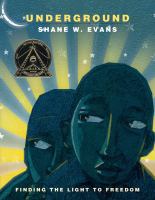
Gr 1-3-A stellar introduction to the Underground Railroad, narrated by a group of slaves. Readers experience the fugitives' escape, their long nighttime journey punctuated by meetings with friends and enemies, and their final glorious arrival in a place of freedom. Evans boils the raw emotion of the experience down to the most compressed statements, both mirroring the minimal opportunities for expression during the secret journey and also creating a narrative that invites even the youngest listeners to visit this challenging subject. For this reason, the text may be read as is to preschool audiences, while the abbreviated prose may also generate a rich discussion for older students. Evans writes simply: "The darkness..../We are quiet./The fear./We run." Appropriately, the narration is told from a group perspective, which reflects the broader experience of enslaved African Americans-a theme continued in his full-bleed illustrations of figures cloaked in the anonymity of night. Though subdued in palette until the eruption of color as the figures reach the threshold of freedom, the author's collaged nocturnal paintings shimmer with an arresting luminescence. Two constants leap out from almost every page: the stars above and the bright, fearful eyes of the fugitives. When the travelers at last lift a newborn baby to the rising sun, readers celebrate along with the protagonists.-Jayne Damron, Farmington Community Library, MI (c) Copyright 2010. Library Journals LLC, a wholly owned subsidiary of Media Source, Inc. No redistribution permitted.
PreS-Gr 3-In this visual tour de force, darkness becomes a protective blanket, hiding "passengers" on the Underground Railroad as they huddle, crawl, and flee to safety. The family members' fear and determination are palpable as is the warming glow of the sun at journey's end. (Jan.) (c) Copyright 2011. Library Journals LLC, a wholly owned subsidiary of Media Source, Inc. No redistribution permitted.
The darkness. / The escape. / We are quiet. / The fear . . . / We run. / We crawl. With just two or three words on each double-page spread, the minimalist text is intense in this stirring picture book about a family's escape from slavery. Dramatic, unframed, mixed-media illustrations, rendered in black lines and dark shades of midnight blue, show a child's view of fleeing and hiding in the night, when the only light is in the starry sky. Then there is the lantern of a safe house, but also of a slave catcher. Finally, freedom comes at last with the glorious color of the sun's light, and the art extends the wordplay in an image of a joyful family holding up their own son a baby boy born in freedom. A long appended note offers more historical context, and young readers can go on from here to other picture-book accounts of families torn apart by slavery and those saved by rescuers on the Underground Railroad.--Rochman, Hazel Copyright 2010 Booklist
With haunting pictures and a few simple sentences, Evans (Black Jack: The Ballad of Jack Johnson) introduces beginning readers to a crucial piece of American history. In darkness lit mainly by moonlight, a slave family is seen sneaking away from a plantation, passing a sleeping overseer ("We are quiet"), creeping through shrubbery, and being greeted by a woman in a skirt and cap holding a lantern high ("We make new friends"). The eyes of the slaves shine with doubt and fear. Dense groupings of figures give a sense of immediacy, and rough charcoal lines echo the rugged paths the group travels. Difficult moments are handled with restraint: "Some don't make it," one page says, as a man with a rifle holds a defeated-looking slave. The slaves press on; the dawn that breaks around them is a metaphor for freedom. A man cradles a pregnant woman ("We are almost there"), and on the next page, he holds a swaddled newborn up to the shining sun in triumph. Telling the story without overwhelming readers is a delicate task, but Evans walks the line perfectly. Ages 4-8. (Jan.) (c) Copyright PWxyz, LLC. All rights reserved.


